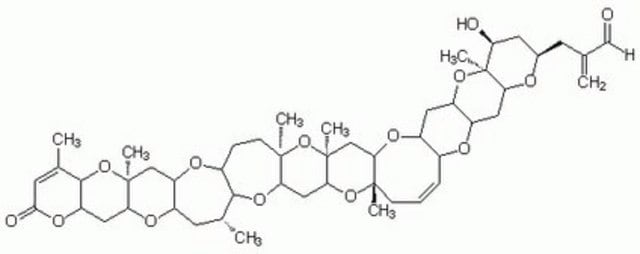203734-M
Brevetoxin PbTx-3, Ptychodiscus brevis
Lipid-soluble polyether marine toxin produced by the red tide dinoflagellate, Ptychodiscus brevis, found along the Gulf Coast of Florida.
Synonym(e):
Brevetoxin PbTx-3, Ptychodiscus brevis, Pumiliotoxin, Dihydrobrevetoxin B
About This Item
Empfohlene Produkte
Qualitätsniveau
Assay
>95% (HPLC)
Form
solid
Hersteller/Markenname
Calbiochem®
Lagerbedingungen
OK to freeze
Löslichkeit
ethanol: 10 mg/mL
DMSO: 30 mg/mL
acetonitrile: 30 mg/mL
chloroform: 30 mg/mL
methanol: 30 mg/mL
water: sparingly soluble
Lagertemp.
−20°C
InChI
1S/C50H72O14/c1-25(24-51)14-28-17-37(52)50(8)41(54-28)19-33-34(61-50)18-32-29(55-33)10-9-12-46(4)42(58-32)23-49(7)40(62-46)21-39-47(5,64-49)13-11-30-44(60-39)26(2)15-31-36(56-30)22-48(6)38(57-31)20-35-45(63-48)27(3)16-43(53)59-35/h9-10,16,26,28-42,44-45,51-52H,1,11-15,17-24H2,2-8H3/b10-9-
InChIKey
BKMHDYJRAAJTAD-KTKRTIGZSA-N
Allgemeine Beschreibung
Biochem./physiol. Wirkung
Voltage-dependent Na+ channel activator
Warnhinweis
Rekonstituierung
Sonstige Hinweise
Rein, K., et al. 1994. J. Org. Chem.59, 2107.
Edwards, R.A., et al. 1992. Mol. Brain Res.14, 64.
Trainer, V.L. 1991. Mol. Pharmacol.40, 988.
Tsai, M.C., and Chen, M.L. 1991. Br. J. Pharmacol.103, 1126.
Trainer, V.L., et al. 1990. ACS Symposium Series418, 166.
Baden, D.G., et al. 1988. Toxicon26, 97.
Poli, M.A., et al. 1986. Mol. Pharmacol.30, 129.
Shimizu, Y., et al. 1986. J. Am. Chem. Soc.108, 514.
Baden, D.G., et al. 1982. Toxicon19, 455.
Catterfall, W.A., and Risk, M. 1981. Mol. Pharmacol.19, 345.
Rechtliche Hinweise
Signalwort
Danger
H-Sätze
Gefahreneinstufungen
Acute Tox. 1 Oral - Aquatic Acute 1 - Aquatic Chronic 1
Lagerklassenschlüssel
6.1A - Combustible acute toxic Cat. 1 and 2 / very toxic hazardous materials
WGK
WGK 2
Flammpunkt (°F)
Not applicable
Flammpunkt (°C)
Not applicable
Analysenzertifikate (COA)
Suchen Sie nach Analysenzertifikate (COA), indem Sie die Lot-/Chargennummer des Produkts eingeben. Lot- und Chargennummern sind auf dem Produktetikett hinter den Wörtern ‘Lot’ oder ‘Batch’ (Lot oder Charge) zu finden.
Besitzen Sie dieses Produkt bereits?
In der Dokumentenbibliothek finden Sie die Dokumentation zu den Produkten, die Sie kürzlich erworben haben.
Unser Team von Wissenschaftlern verfügt über Erfahrung in allen Forschungsbereichen einschließlich Life Science, Materialwissenschaften, chemischer Synthese, Chromatographie, Analytik und vielen mehr..
Setzen Sie sich mit dem technischen Dienst in Verbindung.









